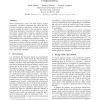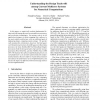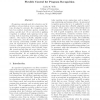1368 search results - page 41 / 274 » Understanding Software Systems Using Reverse Engineering Tec... |
KBSE
2003
IEEE
14 years 2 months ago
2003
IEEE
Modern architectures, such as the Intel Itanium, support speculation, a hardware mechanism that allows the early execution of expensive operations—possibly even before it is kno...
IPPS
2009
IEEE
14 years 3 months ago
2009
IEEE
In this paper, we empirically evaluate fundamental design trade-offs among the most recent multicore processors and accelerator technologies. Our primary aim is to aid application...
WCRE
1993
IEEE
14 years 1 months ago
1993
IEEE
Recognizing commonly used data structures and algorithms is a key activity in reverse engineering. Systems developed to automate this recognition process have been isolated, stand...
AOSD
2007
ACM
14 years 1 months ago
2007
ACM
Most current software systems contain undocumented high-level ideas implemented across multiple files and modules. When developers perform program maintenance tasks, they often wa...
SEW
2005
IEEE
14 years 2 months ago
2005
IEEE
Dealing with dependability requirements is a complex task for stakeholders and analysts as many different aspects of a system must be taken into account at the same time: services...



